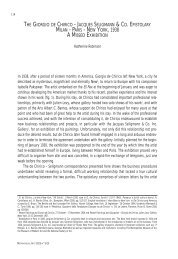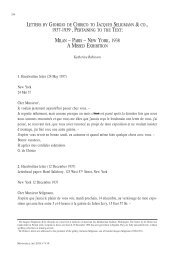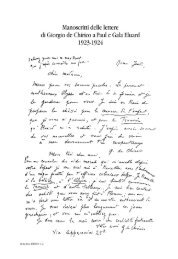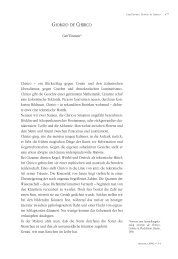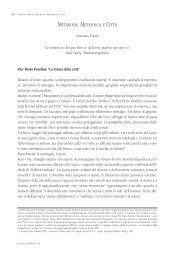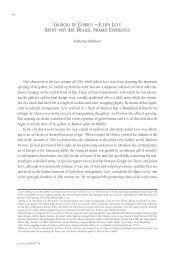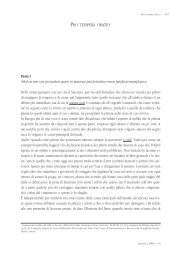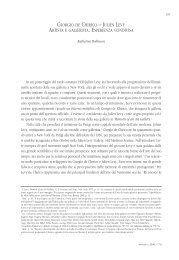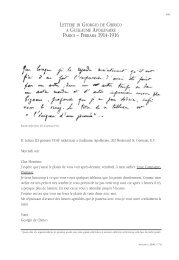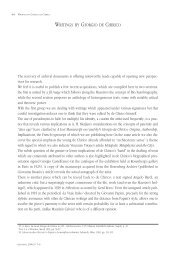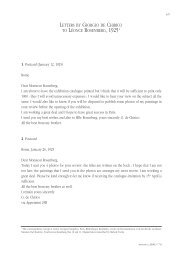Emplastic Oil - Fondazione Giorgio e Isa de Chirico
Emplastic Oil - Fondazione Giorgio e Isa de Chirico
Emplastic Oil - Fondazione Giorgio e Isa de Chirico
You also want an ePaper? Increase the reach of your titles
YUMPU automatically turns print PDFs into web optimized ePapers that Google loves.
184<br />
SALVATORE VACANTI: FROM MURAL PAINTING TO “EMPLASTIC OIL”<br />
fig. 16 A. Trivisonno, Portrait of his Wife Maria<br />
Rosaria, 1941, oil on canvas, private collection<br />
and 1940s, although Trivisonno synthesized the “Return to<br />
Or<strong>de</strong>r” with nineteenth century tradition, which was still<br />
actively present in Southern Italy. His affinities to the<br />
“Valori Plastici” and the Italian Novecento, therefore, do<br />
not stem from cultural or stylistic motives, but rather from<br />
an analogous interest in returning to “craft”. 109<br />
Trivisonno was <strong>de</strong>eply fascinated by Old Masters, particularly<br />
by Renaissance painters, in whose work he recognised<br />
perfection of form, technique and subject matter,<br />
aspects that became a mo<strong>de</strong>l for his own artistic <strong>de</strong>velopment.<br />
From his early youth he was fascinated by painting<br />
technique and the material substance of paint, and <strong>de</strong>voted<br />
himself early on to fresco. In his easel painting (fig. 16),<br />
his language was enriched through his readiness to experiment<br />
with different mediums, such as tempera and oil<br />
painting, even attempting ancient painting techniques such<br />
as encausto. In the 1940s, having returned to Campobasso, he <strong>de</strong>ci<strong>de</strong>d to take lessons in chemistry<br />
in or<strong>de</strong>r to better his un<strong>de</strong>rstanding of the dynamics of materials employed in painting. Thus, after<br />
years of research and earnest experimentation, he <strong>de</strong>veloped an emulsion for oil painting whose<br />
results were so satisfactory that he sold it at a local paint shop. 110<br />
It is here that we see the convergence of <strong>Giorgio</strong> <strong>de</strong> <strong>Chirico</strong> and Ame<strong>de</strong>o Trivisonno’s research.<br />
Both were passionate theorists of painting technique, studying the Old Masters with the objective<br />
of nourishing their experimental research of formulas and blends, a quest further ai<strong>de</strong>d by bibliographical<br />
and documentary sources. Trivisonno, who showed great interest in <strong>de</strong> <strong>Chirico</strong>’s painting,<br />
felt an affinity with his technique, as he also experimented with a painterly medium based on emulsion<br />
at the end of the 1930s and the beginning of the 1940s. In those years Trivisonno kept a journal<br />
on his progress based on the experimentation of various technical methods. He even named<br />
the different bin<strong>de</strong>rs he invented, and faithfully transcribed the historical formulas from which he<br />
took inspiration. 111 After a trip to Venice in 1942 for the Biennale, he noted in his journal (fig. 17):<br />
I saw <strong>de</strong> <strong>Chirico</strong>’s work. I was relieved by the thought that I am not too far off. Some veilings are<br />
obtained with water. Some yellow-brownish drippings suggest the use of glue in the emulsion. The<br />
he moved to Florence where he settled with his family. See L’opera pittorica di Ame<strong>de</strong>o Trivisonno: una pagina <strong>de</strong>ll’arte italiana <strong>de</strong>l Novecento, exhibition<br />
catalogue edited by L. Caramel, M. Fagioli, N. F. Pascarella, E. Pontiggia, Ed. Lampo, Campobasso 1998.<br />
109<br />
See E. Pontiggia, Ame<strong>de</strong>o Trivisonno. Il disegno, in Ame<strong>de</strong>o Trivisonno. Cartoni d’affresco 1927-1939, exhibition catalogue, E. Pontiggia, ed.,<br />
Polistampa, Florence 2000, pp. 17-22.<br />
110<br />
See M. Trivisonno, Note biografiche, in Ibid., pp. 69-77.<br />
111<br />
Between 1942 and 1949 the artist would write in this journal methodological indications of the phases, times and methods of execution of his<br />
works, together with his different observations. The notebook is now held in the private archives of the family in Florence. See R. <strong>de</strong> Benedittis,<br />
Appunti per una pittura veloce, magra e luminosa, in Ame<strong>de</strong>o Trivisonno, Appunti e disegni, exhibition catalogue edited by R. De Benedittis, Ed.<br />
Enne, Campobasso 1998.<br />
METAPHYSICAL ART 2010|N° 9/10



